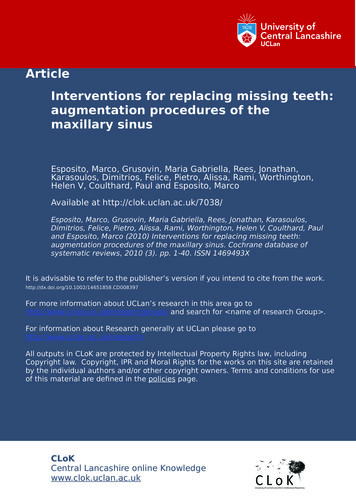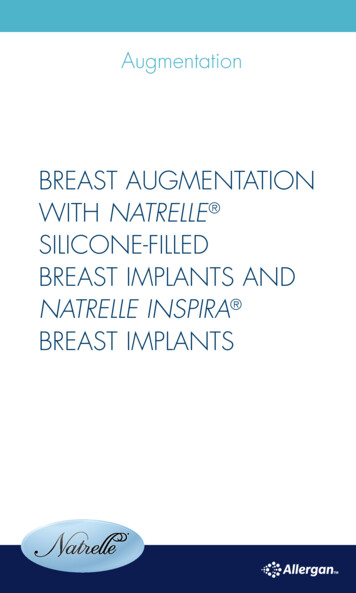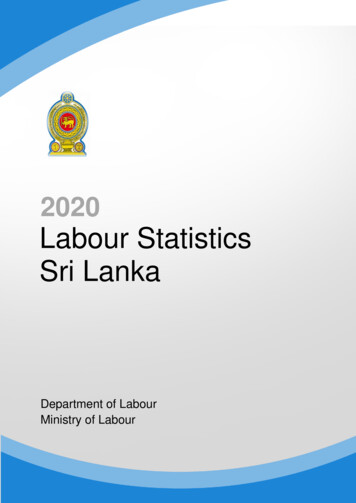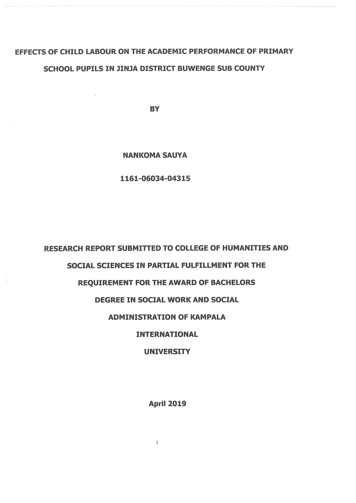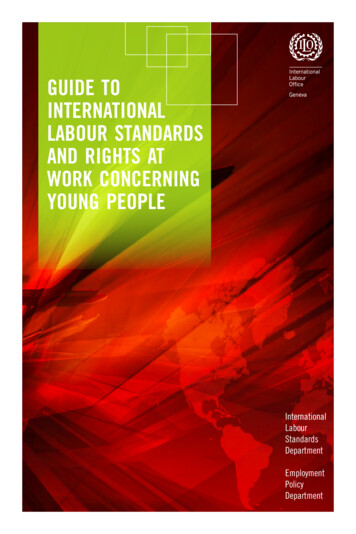
Transcription
Augmentation of labourTorbjørn Moe Eggebø. Stavanger University Hospital tme@sus.noJanne Rossen. Sørlandet sykehus Kristiansand. janne.Rossen@sshf.noLiv Ellingsen, Oslo University Hospital. lellings@ous-hf.noHelene Christine Heide, Bæreum HospitalHeleneChristine.Heide@vestreviken.noSaba Muneer. Akershus University Hospital. Saba.Muneer@ahus.noStian Westad. Lillehammer Hospital. Definition of start of labour (strong recommendation)Definition of start of active labour, WHO definition (4 cm cervical dilation and regularcontractions (recommendation)Use of a partogram (strong recommendation)Definition of slow progress (strong recommendation)Use of alert line and action line (recommendation)Use of WHO's definition with action line delayed by 4 hours (suggestion)Other measures to stimulate contractions such as ebefore theaction line is crossed (proposal)One to one support (strong recommendation)Amniotomy before oxytocin augmentation (strong recommendation)Augmentation with oxytocin is recommended in women with slow progress due toinsufficient contractions (strong recommendation)Oxytocin augmentation may be relevant in nulliparous women with ineffective contractions inlatency phase and effaced cervix dilated 3-4 cm (proposal)Fetal surveillance with CTG should be used in all women accelerated with oxytocin. (strongrecommendation)Consider operative delivery after one hour with active pushing (recommendation)Litterateur searchUp to date, pub-med, National Institute for Health and Clinical Excellence guidelines,Cochrane Database, guidelines from the Royal College of Obstetricians & Gynaecologists,Danish and Swedish timulation is defined as 5 contractions / 10 min or duration of the contraction 2minutes1. Stimulation of contractions should be regarded as the continuation of aphysiological process the body itself has already started (as opposed to induction of labor)2.Stages of labourThe birth contains three stages. First stage lasts from the start of contractions until the cervixis completely dilated. This stage is divided into a latency phase and an active phase. Theactive phase starts, in accordance to the WHO's definition, when cervix is dilated to 4 cm in awoman with regular contractions3-6. Some will define the start of active phase earlier if cervix
is effaced. The second stage lasts from cervix is fully dilated until the child is delivered andthis stage is also divided into a latency phase (until leading part has reached the pelvic floor)and an active phase (time of bearing down)5 .The third stage is the time from the child is bornuntil the placenta is expelled.The partographPartographs have not documented differences in perinatal or maternal morbidity or mortality7and a Cochrane review concludes that the benefits of using a partograph are not documented8.Nevertheless, the partograph is the most important tool in surveillance of labour progress, anduse of a partograph is strongly recommended9 [IV]. Cervical dilation and station is recordedgraphically in the partograph. WHO recommends a partograph with an alert line and an actionline delayed 4 hours. The alert line follows 1cm dilatation / hour.WHO partograph with alert line and action lineSlow progressNo evidence for an upper limit of normal duration exists10 or the definition of how slowprogress should be defined11. However, all labour wards should have their own guidelinedefining slow progress to avoid incautious use of oxytocin augmentation12. Structured careduring birth improves outcomes13 [Ib].First stageThe latency phase can last up to 20 hours in nulliparous and 14 hours in multiparous women3,14. Generally it is recommended that women stay at home in the latency phase, becausehospitalisation is associated with increased use of obstetrical interventions15 [Ib]. However,some women need hospitalization and analgesia. The follow-up should be individualised5.Epidural analgesia can be started in the latency phase without prolonging the labour16.Several definitions of slow progress in the active phase of labor exist. When cervical dilatation crosses the alert line WHO partograph with four hours delay between alert line and action line6, 17 3 hours between the lines18 2 hours between the lines7
No change in dilatation or station within two hours3 2cm change in dilatation during four hours5 Slow progress in the first stage active phase3 1.2 cm / hour in nulliparous women 1.5cm / hour in multiparous womenIn a prospective study women using action line two hours delayed were most satisfied19, butthe use of action line earlier than four hours increases the need of augmentation without betterbirth outcomes5, 8 [Ib]. NICE guidelines suggest using the WHO recommendations5, and weagree.Second stageActive pushing should not start until the fetal head has reached the pelvic floor unless animmediate birth is needed due to fetal distress or suspected infection. Several labour wardspractice one hour as limit for the duration of the latency phase, but other wards accept twohours. Evidence of best practice is limited.Some countries allow two hours of bearing down in nulliparous women5, but it is shown thatactive pushing exceeding 30 minutes is associated with increased risk of asphyxia. Theprobability of spontaneous delivery decreases with duration of bearing down20 [Ib]. Wesuggest considering an operative delivery after 60 minutes of active pushing both innulliparous and multiparous women. This recommendation should also be applied in womenwith epidural analgesia.Causes of slow progressSlow progress in labour may be due to ineffective contractions, malpresentations, fetalmaternal disproportions (pelvis and passenger) or a combination of these factors. Problemsare more common in nulliparous women. Oxytocin augmentation is only indicated in caseswith insufficient contractions.A clinical examination is indicated when slow progress is diagnosed. Recent studies haveshown that fetal position and level can be assessed by ultrasound21 , but routinely use cannotbe recommended due to limited evidence22.Malpresentations as brow, mento posterior or transverse face presentations or posteriorasynclitism are incompatible with vaginal birth, but the malpresenataions often changespontaneously. Most fetuses in occiput posterior position will rotate spontaneously (also inthe second stage)22 [IIb].Actions when slow progress is suspectedAll women in the latent phase should be offered a meal. Eating and drinking is also importantin the active phase and might effect the duration of labour23, 24 [III].Empty the urinary bladderChange maternal position and recommend activityOne to one supervision increases the likelihood of an uncomplicated vaginal delivery25 [Ia].Some studies have shown that acupuncture can shorten duration of labour26, 27 [Ib].Amniotomy shortens duration of labour, but routinely amniotomy is not recommended11, 28.The combination of amniotomy and augmentation with oxytocin is more effective than theuse of the factors alone29 [Ib].Amniotomy should be performed before oxytocin augmentation is startedOxytocin augmentation
Oxytocin augmentation is recommended in women with ineffective contractions. Oxytocinaugmentation shortens birth outcomes [Ia], but an eventual reduction in instrumental deliveryis not documented, although the drug has been used for this indication in over 40 years1, 30, 31.Clinical assessment of the strength of contractions is subjective. A huge variation in the use ofoxytocin augmentation is published, 32-60% among nulliparous women and 14-27% inparous women32, 33.One Swedish study has documented that the use of oxytocin is unstructured12.Oxytocin augmentation does not affect the frequency of instrumental vaginal deliveries inwomen with epidural analgesia34.In a randomised controlled trial early augmentation with oxytocin was not associated withbetter birth experience35.Risks associated to prolonged labourProlonged latency phase and prolonged active birth has been associated with operativevaginal birth, cesarean sections, chorioamnionitt, postpartum haemorrhage, low Apgar scores,and poor birth experience causing request for cesarean section in the next birth19, 36-42. Thepartograph is an important tool in recording labour progress, indications of oxytocinaugmentation and indications for operative interventions9. One to one supervision is importantwhen the progress in slow25.Risks associated to oxytocin augmentationOxytocin is a drug with side effects and misuse may cause serious damage to the mother andfetus43. The sensitivity of the drug is individual, and the augmentation should beindividualised1. Hyperstimulation might affect the placental circulation causing fetal distress1,44, 45. Hyperstimulation is one of the main causes of birth asphyxia43, 46, 47. Oxytocinaugmentation is also associated with uterine rupture, especially in women with a previous scarin uterus48, 49.Two special managementsActive management of labour2This concept from the National Maternity Hospital in Dublin includes: One to one follow-up Duration of the active stage 12 hours Definition of active phase Routinely amniotomy Vaginal examination every second hour Oxytocin acceleration in women with cervical dilatation 1cm/hour after two hours inactive phase in nulliparous women and after four hours in multiparous women.Active management of labour might reduce the need of cesarean sections11, but intensivesurveillance is required50, 51. New evaluations of the concept are recommended4, 51, 52.Proactive labourProlonged latency phase is associated with complications for both mother and child53, 54.Some women ( 10%) have dysfunctional contractions during the latency phase and earlyamniotomy and oxytocin augmentation can bring them into the active phase55. Short andcareful use of oxytocin in this phase is probably associated with less risk compared toaugmentation later in labour. One-to one support is important throughout the birth in thesewomen.
Administration of oxytocinIntravenous infusion of five international units (0.01mg) oxytocin in 500 ml saline should beadministered. The infusion rate starts at 6 milliunits/minute (30 milliliter per hour), and a doseincrement by 3 milliunits/minute (15ml/h) every 15 minutes to a maximum of 40milliunits/minute (180 ml/h) is recommended until progress in labor or regular contractions ata rate of 3-5/10 min are achieved.The use of 0.1ml (1IE) oxytocin im (or iv) during the final stage of labour should be avoidedbecause of increased risk of hyperstimulation and subsequent fetal distress. In exceptionalcases it might be indicated when the fetal head is supposed to be delivered during the nextcontraction. Oxytocin augmentation should not be used in situations with shoulder dystocia.MonitoringThe fetus should be monitored continuously with CTG (or STAN) when the labours areaccelerated with oxytocin5 [IV]. Duration, strengths and frequency of contractions should becontinuously recorded56. Continuous surveillance is mandatory and eventual hyperstimulationshould be observed. Whenever hyperstimulation is suspected the infusion rate should bereduced or abourmanagement- productivehealth/publications/maternal perinatal health/augmentation- al.Obstetricsandgynecology.2006;108:295- graph:anessentialtoolfordecision- ;128:686- 09;88:1352- ‐7.
ecol.1954;68:1568- rolledtrial.Birth.1998;25:5- y:afive- 09;111:871- icaljournal.1972;4:163- .Birth.1999;26:89- ‐96.YliBMKG,RasmussenS,KhouryJ,NorènH,Amer- ‐WåhlinI,SaugstadOD,Stray- 171- 1;37:702- livery:asystematicreviewandbivariatemeta- dinObstetricsandGynecology.2012;40:9- torsassociatedwithactivelabordurationinlow- .ActaObstetGynecolScand.2010;89:1034- stetGynecolScand.2006;85:1348- entduringlabour- ‐- journalofobstetricsandgynaecology.2002;109:637- elayedoxytocinaugmentationtotreatprimary
- lliparouswomenwithprolongedlabour- ‐- journalofobstetricsandgynaecology.2009;116:530- ‐6.OscarssonME,Amer- arerelatedtooxytocinuse.Apopulation- ‐basedstudy.ActaObstetGynecolScand.2006;85:1094- 002;122:1359- L,DenckerA,TaftC,LiljaH,LadforsL,Skaring- ildbirth- Midwives.2012;3:61- ons?ActaObstetGynecolScand.2010;89:1248- inlow- s,gynecology,andreproductivebiology.2011;158:167- sinnulliparouswomen.ObstetGynecol.2010;116:1127- 996;23:144- th.1989;16:109- andinavianjournalofpublichealth.2009;37:364- sychosomaticobstetricsandgynaecology.2009;30:175- S.Severeasphyxiaduetodelivery- ‐relatedmalpracticeinSweden1990- gynaecology.2008;115:316- D,etal.Implementationofaconservativechecklist- Experimentalphysiology.2007;92:621- ‐31.
46.47.48.49.50.51.52.53.54.55.56.JonssonM,Norden- 008;87:745- nNorway.ActaObstetGynecolScand.2012;91:1191- rospectivepopulation- bstetricsandgynaecology.2010;117:1358- colObstet20052005.;89:319- rnalofobstetricsandgynaecology.2003;110:457- reansectionratesinlow- Gynecol.2008;111:204- ecol.1993;81:486- ObstetricsandGynaecology.2002;22:16- urnalofperinatalmedicine.2008;36:30- ‐7.
Liv Ellingsen, Oslo University Hospital. lellings@ous-hf.no Helene Christine Heide, Bæreum Hospital HeleneChristine.Heide@vestreviken.no Saba Muneer. Akershus University Hospital. Saba.Muneer@ahus.no Stian Westad. Lillehammer Hospital. stian.westad@sykehuset-innlandet.no Recommendations Definition of start of labour (strong recommendation)
